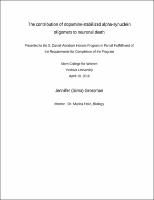Please use this identifier to cite or link to this item:
https://hdl.handle.net/20.500.12202/4096| Title: | The contribution of dopamine-stabilized alpha-synuclein oligomers to neuronal death |
| Authors: | Grossman, Jennifer Sima |
| Keywords: | Parkinson's disease --Etiology. Dopaminergic neurons --Death. Alpha-synuclein. |
| Issue Date: | Apr-2016 |
| Publisher: | Stern College for Women |
| Abstract: | Parkinson’s disease (PD) is a debilitating neurodegenerative movement disorder. Biochemical analysis has revealed that soluble monomeric alpha-synuclein (α-syn) protein aggregates into insoluble fibrillar species in the brains of patients who are afflicted with PD. Previous studies have assessed the possible contribution of α-syn aggregates to the promotion of PD pathology. However, despite the presence of intraneuronal α-syn aggregates throughout brain regions ranging from the brain stem to the neocortex, it is primarily the dopaminergic neurons that form the substantia nigra pars compacta, a midbrain region involved in movement, that die over the course of the disease (Conway et al., 2001). This inconsistency is compounded by the fact that these neurons present with substantially less αsyn aggregates than the neurons of other affected brain regions (Goldberg and Lansbury Jr., 2000). The relationship between α-syn aggregation and the death of neurons that produce dopamine (DA) remains unknown despite its critical importance to the development of effective therapies. It has been suggested that intermediate oligomeric species of α-syn, and not the aggregates themselves, are the primary toxic species involved in PD. Recent studies have determined that oxidized catechols, such as oxidized DA, prevent α-syn from fully aggregating in vitro, instead stabilizing α-syn in an oligomeric form. We have shown that recombinant human WT α-syn oligomers that were produced via stabilization by oxidized DA are toxic to primary neuronal cultures. This may explain the selective susceptibility of dopaminergic neurons in PD. Furthermore, we demonstrated via fluorescent microscopy that these oligomers are internalized into primary neuronal cultures, where they seed the aggregation of endogenous α-syn into pathological species. These findings support the 2 notion that PD is a prion disorder and suggest that DA-stabilized α-syn oligomers are a pathological species involved in PD progression. |
| Description: | The file is restricted for YU community access only. |
| URI: | https://hdl.handle.net/20.500.12202/4096 https://ezproxy.yu.edu/login?url=https://repository.yu.edu/handle/20.500.12202/4096 |
| Appears in Collections: | S. Daniel Abraham Honors Student Theses |
Files in This Item:
| File | Description | Size | Format | |
|---|---|---|---|---|
| Jennifer-Grossman.pdf Restricted Access | 810.27 kB | Adobe PDF |  View/Open |
This item is licensed under a Creative Commons License

